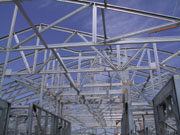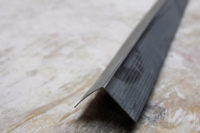
Unfortunately, a confusing development is occurring. As more companies (many with little or no experience in prefabricated components) are entering the light-gauge truss market, the tendency toward incomplete, inaccurate and often misleading truss quotations is growing. On the other hand, experienced truss professionals, who understand and are concerned that their contractor customers receive a complete and accurate proposal, oftentimes find their comprehensive bids unfavorably compared to these less-than-thorough offerings. The result of this scenario is a heightened sense of uncertainty and confusion within the contracting and design firms that are charged with evaluating and selecting among an often-long list of prospective truss suppliers.
Name the system
Here are some simple suggestions to help make separating the wheat from the chaff a little easier.Hold the specification. It seems so obvious but often, specifications are just blatantly ignored. Design professionals spend long hours preparing the best possible specifications for the building owner. However, this exhaustive exercise can be undone in a matter of minutes by the process known as “value engineering.” The old adage “you get what you pay for” holds true in construction material purchase as it does for almost every other transaction. A bid that comes in 20 to 30 percent lower than all others is either the result of a big mistake or doesn’t include everything the specification requires. Either way, there’s guaranteed to be a lot of screaming and finger pointing between the contractor and the truss supplier.
Do a little homework. Know the players likely to provide light-gauge truss proposals on your project. How many years have they been active in the light-gauge truss market? Can they show a portfolio of work that contains a project or two of similar size and complexity to the one you are currently designing/costing? Do they break out their bids and itemize all components, or do they simply provide one “all-inclusive” number? Check references. Verify design and technical resources are available to help when those inevitable job site discrepancies occur.
Understand truss nomenclature and terms. Installation contractors with limited prefabricated truss experience may be unfamiliar with the elements necessary for a properly designed and functioning truss system.
Bracing. Perhaps the most misunderstood and misrepresented issue in the truss industry. All truss systems require bracing—period! If a truss supplier suggests differently, he is misleading you. There are several types of bracing, however, and distinguishing between these is essential.
Installation or “temporary” bracing (a.k.a. construction or erection bracing): Lateral and diagonal bracing that is installed during erection to stabilize the trusses until roof decking is applied. This bracing may be removed after the trusses are decked, or, it may remain and act as part of the permanent bracing system (see Guidelines for proper installation bracing are published by the Light Gauge Steel Engineers Association in the Field Installation Guide for Cold-Formed Steel Trusses).
Installation bracing is typically accomplished with 11⁄2-inch, 20-gauge (minimum) light-gauge furring channel (or hat channel). Other proprietary products exist to provide safe, secure installation bracing and exact truss spacing in one, easy-to-use product.
Some truss fabricators include installation bracing in their proposals, typically as an option. However, many manufacturers make no reference at all to this crucial element. Discuss installation bracing with the various truss providers to properly determine the amount and cost involved.
All light-gauge truss systems require installation bracing. Those truss suppliers that try to convince you that their product requires little or no such bracing are setting a dangerous precedent. Remember, 99.99 percent of all truss collapses are the result of inadequate or improperly installed construction bracing.
Permanent lateral web bracing: Certain long webs or high compression truss webs may require additional reinforcement to resist out-of-plane buckling or bending. Webs requiring such bracing should be identified on the engineered truss drawing. Lateral web bracing, like installation bracing, is typically accomplished with 11⁄2-inch, 20-gauge (min.) hat channel.
In addition to installing lateral web bracing, diagonal bracing is required at specific intervals to transfer the accumulated forces from the web plane to the building. This diagonal bracing is an essential element of the permanent bracing system and should be designed and specified by the engineer of record or project engineer.
One area of great importance for installers and contractors is when truss webs do not “line-up.” In other words, there is not—on either side of the truss in question—a similar truss with a web to which the initial web can be braced. This happens very frequently in hip ends or “cut-up” roofs where there are many different truss types—few or any with consecutive runs greater than one or two. In these cases, “T” bracing is necessary.
“T” bracing is accomplished by attaching a reinforcing member along the entire length of the web requiring bracing. In wood trusses, this typically takes the form of a 2x4 nailed to the side of the web, thus creating a “T” section
In light-gauge steel, “T” bracing can be accomplished in a similar manner. Typically, a standard cee stud is attached the length of the web during or after installation. When reviewing proposals, be sure to inquire as to how and where lateral web bracing is to be applied and if and how any T-bracing is to be accomplished. If the fabricator cannot answer these questions, you should consider another source for your trusses.
Permanent top and bottom chord bracing: Permanent bracing in the truss system provides overall roof system stability as well as resistance to wind and other lateral forces. Roof decking directly attached to the truss typically provides permanent top chord bracing. For steel trusses spaced 24 inches on center, this decking is typically treated plywood. For trusses 48 inches o.c. (or greater), a structural metal deck is often utilized, although, purlins spaced 24 inches o.c. with plywood on top is another option for wide-spaced trusses.
A rigid ceiling is directly attached is common for bottom chord permanent bracing for truss systems spaced 24 inches o.c. or less. For wider spaced systems (or 24 inch o.c. systems with a suspended ceiling), lateral bracing (and corresponding diagonal bracing) typically spaced at 5 or 6 feet is applied to the top of the truss bottom chord, with a suspended ceiling dropped from the trusses. In lieu of drop ceilings in wide spaced systems, furring channels can be attached to the truss bottom chords at 24 inches o.c., with drywall attached to these channels.
Once again, it is absolutely essential for the contracting firm that is purchasing the light-gauge truss package to determine whether or not permanent top and bottom chord lateral and diagonal bracing is provided by the truss fabricator. Thoroughly review all proposals, as well as the truss specification, to determine where responsibility lies for these absolutely essential elements.
Layout: A truss placement diagram usually prepared by the truss fabricator. Layouts should be a part of any serious truss proposal.
Sealed drawings: Also known as stamped drawings or shop drawings, these are individual truss drawings that have been reviewed and certified by a professional engineer registered in the state in which the trusses will be installed. Such review is almost universally required and must therefore be included in the truss suppliers bid.
Truss-to-truss connections: Light-gauge truss fabricators should be willing and able to provide all the design services and material necessary to connect all their trusses together. This includes hip jacks, girder, corners, and various other truss-to-truss conditions that might occur in a truss system. Identify these products on the quotations you receive.
Truss-to-bearing connections: Also known as truss-to-structure or truss-to-bearing connections. Like truss-to-truss connections, light-gauge truss fabricators should be able to provide the engineering and product to accomplish these connections. In some cases, the engineer of record may have already specified truss-to-bearing conditions. In either case, be sure to identify these products on the quotations you receive.
Obviously, light-gauge steel trusses are much more involved than “metal triangles that hold up the roof” as referred to by one contractor. Trusses are a precisely engineered and integrated system of individual elements that work together to provide a safe and economical structural solution for a wide range of building categories. The proper design and coordination of these elements is absolutely essential. W&C

